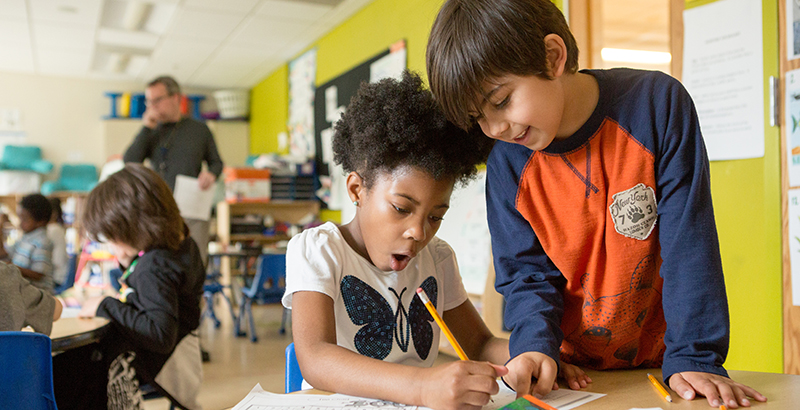Joshi: A High-Quality Education Isn’t Just Rigorous, It Also Affirms Students’ Cultural Identities. Here’s How

Get stories like these delivered straight to your inbox. Sign up for The 74 Newsletter
Last month, students headed back to schools in person, some for the first time in 18 months. My own son, a curious, creative and kind 6-year-old, walked into his school for the first time ever. After a year of virtual kindergarten, he was excited to meet his teachers and classmates and explore his school, but also nervous, unsure of his place and path in such a big building. My feelings mirrored his: hope for a loving, joyful, rigorous classroom environment coupled with trepidation. Would his school experience be different from mine? Would he find an inclusive, welcoming environment or, like me, be made to feel like an “other”? Would his identity and cultural gifts be celebrated or, like me, would he long for his culture reflected in his learning in a way that goes beyond just food and flags?
Historically, curricula and instruction were deemed high-quality without consideration for their responsiveness to students’ identities, cultures and languages, but we know now that identity-affirming education is effective education. To that end, instructional materials — and the professional learning associated with them — need to be examined, supplemented and, sometimes, revised to ensure all students can bring their unique experiences to learning. Children students are unique, resilient and adaptable to new environments. Shouldn’t their instruction be the same?
Research has shown that a focus on culturally responsive and sustaining education in professional learning shifts teacher mindsets and practice and, ultimately, leads to increases in student achievement. At Teaching Lab, we saw this borne out when we worked with 72 K-5 teachers from New York City’s District 11 in a virtual professional learning community that was designed to equip teachers to implement culturally responsive and sustaining education in their daily instruction. Specifically, they learned to use each of their students’ unique cultural identities and skill sets with the goal of improving achievement. In focus groups conducted after the series, participants reported that they realized their focus on culture before the session was superficial and limited to certain times, such as Black History Month. Now, they intend to plan their lessons from a culturally responsive and sustaining education lens, looking for opportunities to expose students to a variety of cultures and being aware of phrasing that may inhibit some students’ understanding, all while maintaining academic rigor and ensuring a feeling of joy in the classroom.
From our work integrating these principles into professional learning, here are several recommendations for teachers and school leaders to make this work successful.
- Advocate for and engage in time to build this knowledge, reflect on practice and consider how it can be applied. It takes time and effort for educators to understand what culturally responsive and sustaining education is, find ways to incorporate it into the curriculum and classroom and engage in proper followup. To give them this time, school leaders can organize collaborative book studies of works by experts and dedicate time during professional learning to reflect on instructional materials and practice, plan lessons with cultural responsiveness in mind and share experiences.
- Reflect on how your identities as a learner, educator and leader influence the ways you teach and lead and how your students learn. Teachers can use these reflections to craft a vision for the instructional experience in their classroom. For example, a math teacher can consider these questions:
- All students have a mathematics identity — for example, they may see themselves as a capable math learner, or they may think they’re just not a “math person.” What range of mathematics identities do your students exhibit?
- What actions do you take to positively affirm your students’ mathematics identities?
- What aspects of your own history with learning mathematics have an impact on your views about teaching math?
- Integrate culturally responsive and sustaining education into your instructional practice, in any content area or set of high-quality instructional materials. Free, customizable open educational resources can be easily adapted to students’ needs and cultures. Leaders and teachers can also make it a habit in their lesson planning to reflect on cultural responsiveness. For example, an English language arts teacher can consider questions like, “What opportunities are there to connect this topic to students’ cultures?” while preparing for a module, unit or lesson. Teachers can also incorporate inclusive practices into instruction, such as assigning nonfiction books that build on students’ interests and giving them the option to sketch or doodle what they’re learning rather than writing or taking notes.
We must redefine “high quality” to include both academic rigor and cultural responsiveness — it’s not an either/or. To remove barriers for all students to succeed, education leaders need to invest time and resources to teach educators to support students to meet grade-level expectations through culturally responsive and sustaining education. When teachers and leaders do this, they create classroom environments where all students thrive and receive joyful and rigorous instruction that affirms their identities.
Vaishali Joshi is senior director of impact and innovations at Teaching Lab.
Get stories like these delivered straight to your inbox. Sign up for The 74 Newsletter

;)